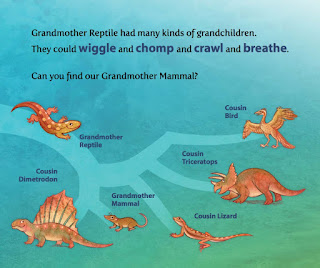 |
| The amniote clade split into countless smaller clades. |
Clades in Grandmother Fish
Last week the printer shipped me two of the first finished copies of Grandmother Fish, which I raised money for last year on Kickstarter. There’s a lot I can say about Grandmother Fish: the 15 years I’ve been working on it; the help I got from science communicators, parents and children; how Karen’s art brought out the soft side of evolution; the difficulty of turning evolution into a story; or the power of kinesthetic learning. Today what’s on my mind is the concept of clades. In the old way of thinking, each living thing went into one or another categorical bucket, as in bird, reptile or mammal. In terms of clades, there are no buckets. Instead there are countless branch points, each leading on to more branch points. A clade is an ancestral population and all living things that ever descended from that population. Each time the evolutionary tree of life branches, both new branches are still part of the original clade, but each also represents a smaller clade of its own. Grandmother Fish shows children how living things are related, branch by branch. What excites me about this is that it demonstrates a new way of thinking about relatedness. In the old way of thinking, amphibians, reptiles, birds and mammals were all classes of vertebrate. In the new way of thinking, reptiles and birds are in one clade, with mammals in a sister clade. Those two clade combine in the amniote clade, with amphibians as their sister clade. Then the amniotes and amphibians combine in the tetrapod clade, and so on. Where 19th century scientists saw tetrapods as four classes, 21st century scientists see them as countless nested populations defined by sequential branching in the family tree. That’s one of the subtexts of Grandmother Fish, that we organize living things according to their lines of evolutionary descent.
Creationists can’t create a book to match Grandmother Fish. They have no cogent explanation for why animals resemble each other the way they do. The evolutionary family trees in Grandmother Fish show children how various sorts of animals are related to each other. Creationists can’t even generate a list of which animals are which kind. They say that each animal is in one and only one kind, and that these kinds have biological reality, but they can’t assign each animal to a kind. That’s because animals come in clades, not kinds. Relationships among animals are complex. Creationism reduces relationship down to a single factor: for any two animals, are they the same kind or not? Evolution posits a more complex and informative question: for any two animals, what was their most recent common ancestor, what was it like, when did it live, and where? That’s what the five Grandmothers are in Grandmother Fish, they’re common ancestors found at major branch points in the history of our lineage.
The two-page phylogenetic tree in Grandmother Fish was a stretch goal, and I’m glad we added it to the book. Getting each branch point in the right sequence was a challenge, especially because genetic testing is rewriting the tree year by year. But the hard work means that these two pages include a large amount of scientific information, all distilled down to a simple, visually appealing diagram. It’s the sort of information that one can’t imagine without understanding the concept of common descent.
Creationists can’t create a book to match Grandmother Fish. They have no cogent explanation for why animals resemble each other the way they do. The evolutionary family trees in Grandmother Fish show children how various sorts of animals are related to each other. Creationists can’t even generate a list of which animals are which kind. They say that each animal is in one and only one kind, and that these kinds have biological reality, but they can’t assign each animal to a kind. That’s because animals come in clades, not kinds. Relationships among animals are complex. Creationism reduces relationship down to a single factor: for any two animals, are they the same kind or not? Evolution posits a more complex and informative question: for any two animals, what was their most recent common ancestor, what was it like, when did it live, and where? That’s what the five Grandmothers are in Grandmother Fish, they’re common ancestors found at major branch points in the history of our lineage.
The two-page phylogenetic tree in Grandmother Fish was a stretch goal, and I’m glad we added it to the book. Getting each branch point in the right sequence was a challenge, especially because genetic testing is rewriting the tree year by year. But the hard work means that these two pages include a large amount of scientific information, all distilled down to a simple, visually appealing diagram. It’s the sort of information that one can’t imagine without understanding the concept of common descent.
No comments:
Post a Comment
Note: Only a member of this blog may post a comment.